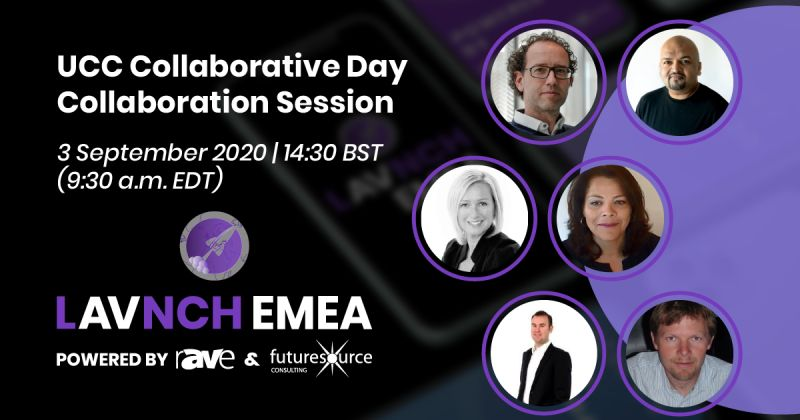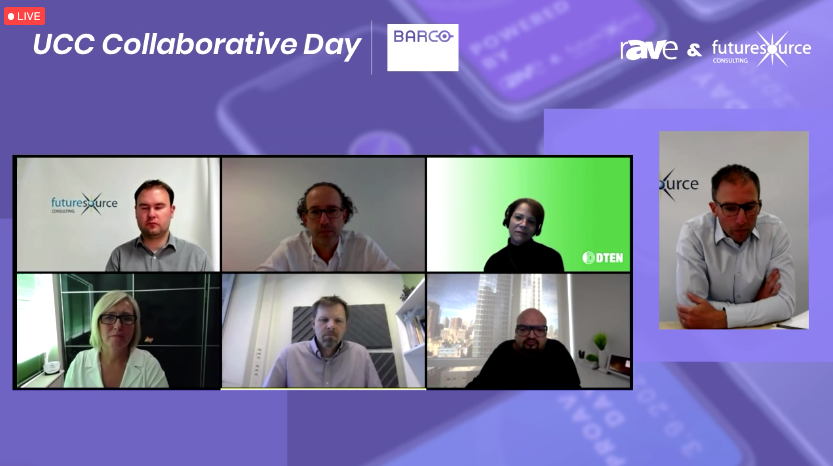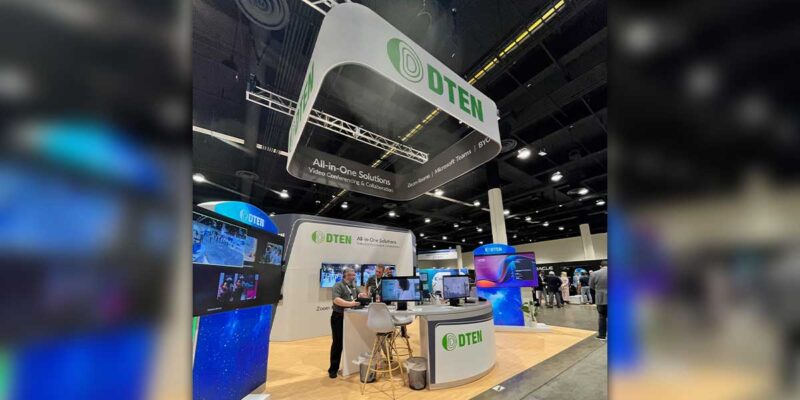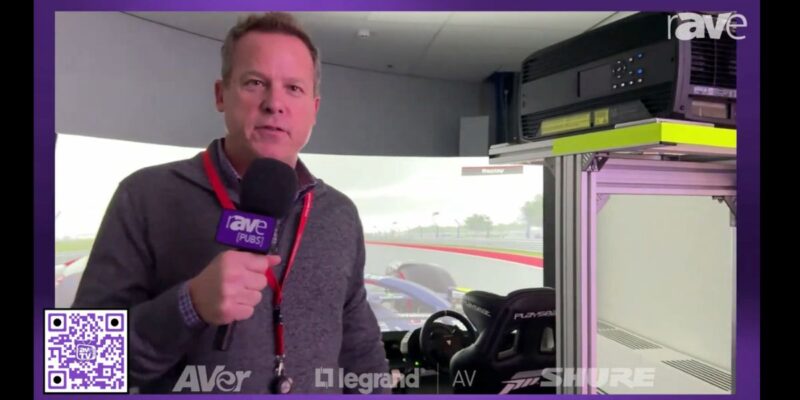A Recap of LAVNCH EMEA’s Collaboration Session
What better LAVNCH EMEA session to recap on UCC Collaborative Day than the one titled “Collaboration Session?” I’m not being facetious; I was really excited to hear what this one had in store. And I was excited for the familiar faces in it: Jane Hammersley of Collabtech, Lieven Bertier of Barco, Nia Celestin of DTEN, Finn Helge Lunde of Cisco and, last but not least, TJ Varghese of Google.
Our recap is just a short scroll down below.

Futuresource’s Adam Cox was the intro speaker and session moderator for “Preparing for the Second Wave: Collaboration in a Post-COVID-19 World.” To start, he asked: Why has it taken a pandemic for unified communications & collaboration (UC&C) to become so important? A number of factors were (and are) at play, one of which is that UC&C solutions just require a different way of working and thinking. Plus, there just wasn’t as much need for it before.
Between 2017 and 2019, there was already tremendous volume growth in collaboration tools — wireless presentation display (WPS) technology (120%) and video conferencing hardware (103%). But it took a pandemic to make those tools essential.
The pre-COVID meeting room:
- The meeting room has traditionally been the collaborative hub
- Conferencing tools tended to be point to point
- Technology focused more on in-room needs
- Collaboration tools seen as “nice to have” by many
The reimagined meeting room:
- The meeting room is now part of a wider chain of end points
- Flexibility in conferencing is essential
- Technology must serve in-room and remote users
- Collaboration tools are now business-critical investments
With new challenges come new considerations, Cox continued. There’s reluctance to touch surfaces, fears of a second pandemic wave, challenges in tracking and tracing, and of course all the considerations around flexible working culture. One big opportunity is the home office — who buys the products: the end user or the company? With regards to marketing, there are so many factors to think about too — different products, different brands, different channels. In the future of office working, Cox added, offices are set to be revolutionized with more meeting rooms and larger meeting rooms. Technology can provide some solutions, and we look forward to seeing how office design will change in tandem.
After Cox’s breakdown on UC&C post-COVID (once we’ve actually reached that point), our panelists joined the feed.

The panel was wildly full of good insights, so I’ll just recap a takeaway or two from each guest.
- Jane Hammersley: “Here we are living collaboration every single day,” Hammersley started. Important to remember is that work is a thing we do, not a place we go to do it, she added. We can be as effective in a remote location as we can in an office location. The pandemic has forced us to debate how we encourage users (not just the organizations) to get the most use out of the platforms they’re probably already equipped with.
- TJ Varghese: An interesting element is the different market segments — education, for instance, which didn’t have mainstream remote learning before the pandemic. People started to realize, as they had human connection and were using videoconferencing for their personal lives, there’s a natural tendency to have connection within the virtual workplace too. A lot of reasons forced that changed, making it go from “want” to “need.”
- Lieven Bertier: It’s been ten years of progress in three months time, Bertier echoed. But the pandemic has just functioned as an accelerator — it wasn’t something new. Bertier argued that this is an experimentation phase: In the beginning, everyone was so happy working from home; now we’re seeing some of the negative. A few months into the crisis, Bertier thinks we’re finding a new balance — it’s hard to predict, but he’s optimistic we’ll find it. Bertier added that we’ll also be bringing new habits into the office, with raised expectations (a challenge to employers). All meetings will now be remote meetings — whereas, in the past, it skewed to mostly in-person attendees and a few remote workers.
- Nia Celestin: In terms of meeting rooms, Celestin’s take is that room structure and design will change to smaller spaces for personal use at the office; she thinks there will be more ways to share rooms but not all at the same time. We’ve already seen things like phone booths and focus rooms, and Celestin thinks these rooms will accelerate, accomodating videoconferencing in places like executive offices and individual offices. It’s also a question of how we work together. Brainstorming and ideation are functional needs that will still be there. We’ll also need to push the envelope to help users’ fear of adopting new technology.
- Finn Helge Lunde: Unlike Hammersley, Lunde does think we’re currently experiencing a cultural change right now. Before, hybrid working was self-driven but not supported per se. He added that we need to keep paying attention to the new challenges popping up; the quicker we are to innovate, the better we can support the change — while recognizing it is hard to innovate upon the unknowns.
As an industry, we can evangelize and innovate on the cultural shifts — in-office and at home. Organizations are now realizing that flexible working works and benefits employees, and many think we’ll start to see better talent retention and acquisition. We need to keep relaying that message out to organizations, the panel argued today. What’s exciting is that our industry can (and will) continue forward with even more innovations coming out of this.
If you missed this UCC Day Collaboration Session, we have news: You can still register to view the LAVNCH EMEA archives! Register here before catching the next story:
UC Audio, the Task-Based Workforce and Market Catalysts — Oh My!




